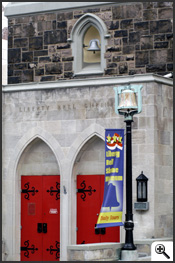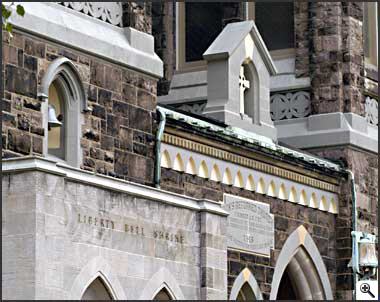|

The Liberty Bell traveled several times before settling into its current home. As early as September 1777, as British troops closed in on the city of Philadelphia, the Bell was removed from the State House (now Independence Hall) and hauled by wagon to Allentown, Pennsylvania, where it was stored for safekeeping in the Zion Reformed Church.
The Bell came home again to the State House in 1778, but by that point the building’s elegant steeple was so rotted the Bell was simply stored at the tower’s mid-level, instead of being rehung to peal from the top. In 1852, after attempts to repair the now-famous crack had failed and it was clear the Bell would never ring again, it was taken down from the tower and displayed in a small museum in Independence Hall. This would remain its home for more than a century—although it was hardly a resting place. The Bell was so popular that it was often called away on tour.
 One of the most important of the tours was conceived in November 1884, when the special commissioner for the World’s Industrial and Cotton Exposition in New Orleans made a patriotic plea for the Bell to be sent down for the event. Philadelphia Mayor William B. Smith, who recognized that the Liberty Bell could serve as a potent symbol of America’s reunification after the Civil War, was all for the idea. One of the most important of the tours was conceived in November 1884, when the special commissioner for the World’s Industrial and Cotton Exposition in New Orleans made a patriotic plea for the Bell to be sent down for the event. Philadelphia Mayor William B. Smith, who recognized that the Liberty Bell could serve as a potent symbol of America’s reunification after the Civil War, was all for the idea.
The City of Brotherly Love, he wrote, “is anxious to aid in the restoration of perfect harmony throughout the nation.” And indeed, as the Bell made its way through the South toward New Orleans in 1885, it was greeted with speeches and ceremony at every stop. One such reception was near the Mississippi home of Jefferson Davis, former president of the Confederacy, who expressed the mood of the moment: “You, sacred organ, gave voice to the proudest declaration that a handful of men ever made . . . Glorious old Bell, the son of a Revolutionary soldier bows in reverence before you.”

The Liberty Bell’s last extended trip came in 1915, when it journeyed to the Panama Pacific Exposition in San Francisco. Once again, enthusiastic crowds greeted the Bell at every stop. Many people also had their pictures taken with the Bell—among them Thomas Alva Edison.
The Bell made its next-to-last trip in the Bicentennial year of 1976, when it moved across the street from Independence Hall into a new building designed to handle larger crowds. Now, the Bell travels again, moving into its new home at the corner of 6th and Chestnut Streets in Philadelphia, housed within a museum that tells its many stories, the National Park Service Liberty Bell Center.
** Photo Credits: Peter West, National Science Foundation
|









